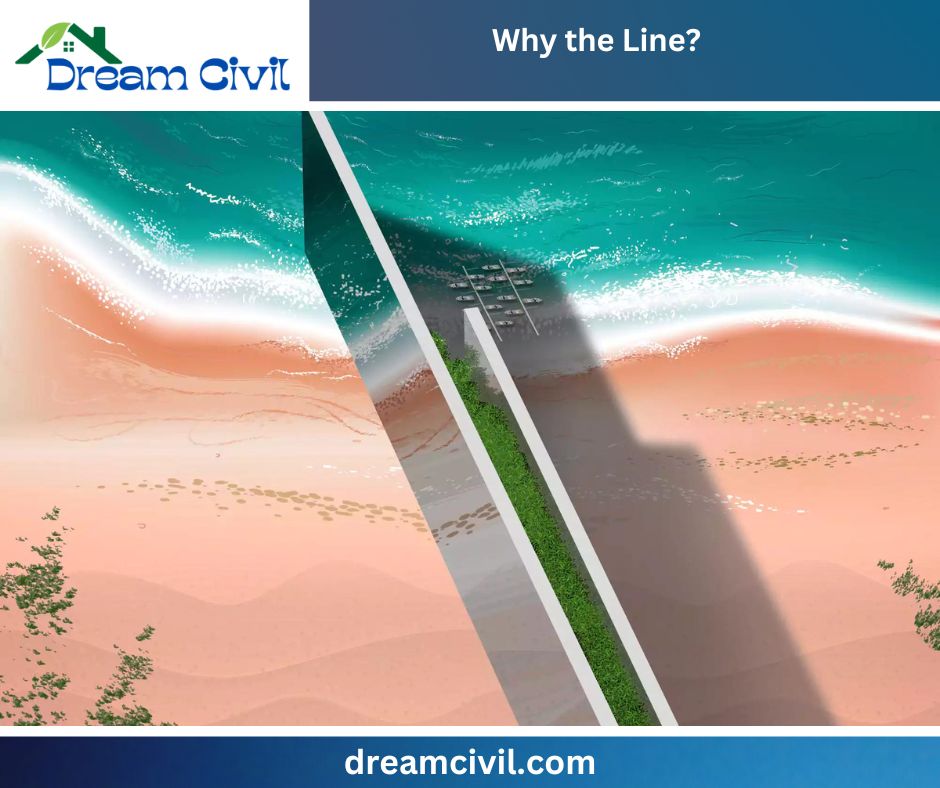Table of Contents
The Line City is a futuristic smart city currently being built in Neom, Tabuk Province, Saudi Arabia. This innovative city is designed to be free from cars, streets, and carbon emissions. This article provides an overview of The Line City, including its feasibility, design, and construction details.
| Read More: The Panama Canal: Map, History, Cruises, and Construction |
A. Where is The Line City?
✓ Saudi Arabia
B. Who is creating The Line City?
✓ Saudi Crown Prince Mohammed Bin Salman
C. How many people can live in The Line?
✓ 9 million people
D. Is The Line a smart city?
✓ The Line is an intelligent city equipped with Artificial Intelligence that monitors the city and its residents. By utilizing predictive models and big data, it aims to enhance the daily lives of its citizens.
E. What is unique about The Line City?
✓ This is a one-of-a-kind city featuring two enormous, uninterrupted lines of skyscrapers with living areas in between. It is designed to stretch 170km in length, be 200m wide, and stand at a towering height of 500m, surpassing the tallest buildings in Europe, Africa, and Latin America. This city is anticipated to house nine million inhabitants, making it the most populous city in Saudi Arabia.
F. Why is Saudi Arabia building The Line?

✓ The Line has been designed explicitly for high-speed train travel. With only four stops, this train can traverse the city in just 20 minutes. The straight line structure is essential in achieving this speed goal, as one massive train line can serve the entire town.
G. Describe briefly about The Line City ( Neom, Saudi Arabia ).

✓ A zero-emission and car-free city called The Line is currently being proposed to be built in Saudi Arabia.
✓ Spanning 170 kilometers (106 miles) in the Tabuk Province, it is estimated that the city will have a population of 9 million and aims to be completed by 2025.
✓ The NEOM company is behind this ambitious $500 billion project to establish a new economic hub in Saudi Arabia.
✓ The Line will be a sustainable city, utilizing renewable energy sources and prioritizing public transportation by prohibiting private cars.
✓ Autonomous pods and public buses will be the primary mode of transportation, and the city will be powered by 100% renewable energy.
✓ It will also be built with sustainable materials and practices and designed to be a healthy and vibrant city with ample green space and open areas.
✓ The Line is still in its early stages of development but has the potential to revolutionize urban planning.
✓ Its linear design and car-free concept could pave the way for sustainable, efficient, and livable cities in the future.
✓ It will be interesting to see how the city develops and if it can achieve its ambitious goals.
H. What is the feasibility of The Line City?

✓ The feasibility of The Line City is a contentious topic among experts. While some believe the project is too ambitious to achieve its goals, others see it as a groundbreaking development in urban planning.
However, The Line City faces several significant challenges.
✓ Firstly, its construction cost is estimated at a staggering $200 billion, and the project will require a vast amount of land, which is in short supply in Saudi Arabia.
✓ Additionally, the city must rely solely on renewable energy sources, a significant challenge in a country heavily dependent on fossil fuels.
✓ Finally, the city must be designed to be sustainable and resilient to climate change.
Despite these challenges, there are potential benefits to The Line City, such as reducing traffic congestion and air pollution, creating jobs, and boosting the economy.
✓ Several arguments support the feasibility of The Line City, including NEOM’s considerable financial resources and the Saudi government’s commitment to Neom’s development.
✓ Additionally, leading architects and engineers are designing the city, and there is a growing demand for sustainable and livable cities.
✓ However, there are arguments against the project’s feasibility, including its ambitious nature, high construction costs, and the difficulty of relying solely on renewable energy and designing a sustainable and climate-resilient city.
✓ Ultimately, only time will tell whether The Line City is feasible. Nevertheless, it is a bold and ambitious project that has the potential to revolutionize urban planning.
H. Explain the design and construction of The Line City.

✓ The proposed design and development of The Line City is still in its early stages, but several vital features have been suggested.
1. Following a linear layout, The city will span 170 kilometers (106 miles) from the Red Sea to the desert’s edge.
2. It will be a car-free city, with autonomous pods and public buses serving as the primary mode of transportation.
3. The city will operate on 100% renewable energy and be constructed with sustainable materials and practices.
4. It will be designed to encourage a healthy lifestyle, with ample green spaces and open areas.
✓ The city will consist of 16 districts, each with its unique character and connected by pedestrian and bicycle paths. A high-speed transit system will link the city to other parts of Neom.
✓ While the concept of The Line City is still in the planning phase, NEOM company is committed to making it a reality, though it is not yet known how it will be financed or built.
✓ The designers and engineers of The Line City will face several challenges, including creating a livable and sustainable city without cars, powering the city with renewable energy, constructing it with sustainable materials, and ensuring its resilience to climate change.
✓ Overcoming these obstacles is essential to the project’s success, but it has the potential to be a significant breakthrough in urban planning.
✓ The city could be an example of how to build sustainable, efficient, and livable cities.

